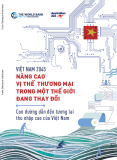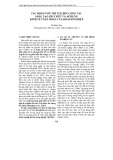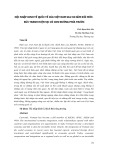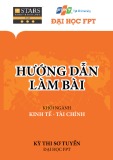
Chapter 2
Thinking Like An Economist
TRUE/FALSE
1. Economists try to address their subject with a scientist’s objectivity.
ANS: T DIF: 1 REF: 2-1
NAT: Analytic LOC: The study of economics and definitions of economics
TOP: Economists MSC: Definitional
2. Economists devise theories, collect data, and then analyze these data in an attempt to verify or refute their
theories.
ANS: T DIF: 1 REF: 2-1
NAT: Analytic LOC: The study of economics and definitions of economics
TOP: Economists MSC: Definitional
3. The scientific method is the dispassionate development and testing of theories about how the world works.
ANS: T DIF: 1 REF: 2-1
NAT: Analytic LOC: The study of economics and definitions of economics
TOP: Scientific method MSC: Definitional
4. The scientific method can be applied to the study of economics.
ANS: T DIF: 2 REF: 2-1
NAT: Analytic LOC: The study of economics and definitions of economics
TOP: Scientific method MSC: Interpretive
5. While the scientific method is applicable to studying natural sciences, it is not applicable to studying a
nation’s economy.
ANS: F DIF: 2 REF: 2-1
NAT: Analytic LOC: The study of economics and definitions of economics
TOP: Scientific method MSC: Interpretive
6. For economists, conducting experiments is often difficult and sometimes impossible.
ANS: T DIF: 1 REF: 2-1
NAT: Analytic LOC: The study of economics and definitions of economics
TOP: Economists MSC: Definitional
7. Economists usually have to make do with whatever data the world happens to give them.
ANS: T DIF: 1 REF: 2-1
NAT: Analytic LOC: The study of economics and definitions of economics
TOP: Economists MSC: Definitional
8. It is difficult for economists to make observations and develop theories, but it is easy for economists to run
experiments to generate data to test their theories.
ANS: F DIF: 2 REF: 2-1
NAT: Analytic LOC: The study of economics and definitions of economics
TOP: Economists MSC: Interpretive
9. Since economists cannot use natural experiments offered by history, they must use carefully constructed
laboratory experiments instead.
ANS: F DIF: 2 REF: 2-1
NAT: Analytic LOC: The study of economics and definitions of economics
TOP: Economists MSC: Interpretive
49

50 Chapter 2/Thinking Like An Economist
10. Historical episodes are not valuable to economists.
ANS: F DIF: 2 REF: 2-1
NAT: Analytic LOC: The study of economics and definitions of economics
TOP: Economists MSC: Interpretive
11. Historical episodes allow economists to illustrate and evaluate economic theories of the present.
ANS: T DIF: 1 REF: 2-1
NAT: Analytic LOC: The study of economics and definitions of economics
TOP: Economists MSC: Definitional
12. Good assumptions simplify a problem without substantially affecting the answer.
ANS: T DIF: 2 REF: 2-1
NAT: Analytic LOC: The study of economics and definitions of economics
TOP: Assumptions MSC: Interpretive
13. Assumptions can simplify the complex world and make it easier to understand.
ANS: T DIF: 1 REF: 2-1
NAT: Analytic LOC: The study of economics and definitions of economics
TOP: Assumptions MSC: Definitional
14. Economists often find it worthwhile to make assumptions that do not necessarily describe the real world.
ANS: T DIF: 2 REF: 2-1
NAT: Analytic LOC: The study of economics and definitions of economics
TOP: Economists MSC: Interpretive
15. Economists use one standard set of assumptions to answer all economic questions.
ANS: F DIF: 2 REF: 2-1
NAT: Analytic LOC: The study of economics and definitions of economics
TOP: Economists MSC: Interpretive
16. Economic models are most often composed of diagrams and equations.
ANS: T DIF: 1 REF: 2-1
NAT: Analytic LOC: Understanding and applying economic models
TOP: Economic models MSC: Definitional
17. Economic models omit many details to allow us to see what is truly important.
ANS: T DIF: 1 REF: 2-1
NAT: Analytic LOC: Understanding and applying economic models
TOP: Economic models MSC: Definitional
18. Economic models can help us understand reality only when they include all details of the economy.
ANS: F DIF: 2 REF: 2-1
NAT: Analytic LOC: Understanding and applying economic models
TOP: Economic models MSC: Interpretive
19. An economic model can accurately explain how the economy is organized because it is designed to include, to
the extent possible, all features of the real world.
ANS: F DIF: 2 REF: 2-1
NAT: Analytic LOC: Understanding and applying economic models
TOP: Economic models MSC: Interpretive
20. All scientific models, including economic models, simplify reality in order to improve our understanding of it.
ANS: T DIF: 1 REF: 2-1
NAT: Analytic LOC: Understanding and applying economic models
TOP: Economic models MSC: Definitional

Chapter 2/Thinking Like An Economist 51
21. The circular-flow diagram explains, in general terms, how the economy is organized and how participants in
the economy interact with one another.
ANS: T DIF: 2 REF: 2-1
NAT: Analytic LOC: Understanding and applying economic models
TOP: Circular-flow diagram MSC: Interpretive
22. A circular-flow diagram is a visual model of the economy.
ANS: T DIF: 1 REF: 2-1
NAT: Analytic LOC: Understanding and applying economic models
TOP: Circular-flow diagram MSC: Definitional
23. In the circular-flow diagram, households and firms are the decision makers.
ANS: T DIF: 2 REF: 2-1
NAT: Analytic LOC: Understanding and applying economic models
TOP: Circular-flow diagram MSC: Interpretive
24. In the circular-flow diagram, firms produce goods and services using the factors of production.
ANS: T DIF: 2 REF: 2-1
NAT: Analytic LOC: Understanding and applying economic models
TOP: Circular-flow diagram | Factors of production MSC: Interpretive
25. In the circular-flow diagram, factors of production are the goods and services produced by firms.
ANS: F DIF: 2 REF: 2-1
NAT: Analytic LOC: Understanding and applying economic models
TOP: Circular-flow diagram | Factors of production MSC: Interpretive
26. In the circular-flow diagram, factors of production include land, labor, and capital.
ANS: T DIF: 2 REF: 2-1
NAT: Analytic LOC: Understanding and applying economic models
TOP: Circular-flow diagram | Factors of production MSC: Interpretive
27. In the circular-flow diagram, firms own the factors of production and use them to produce goods and services.
ANS: F DIF: 2 REF: 2-1
NAT: Analytic LOC: Understanding and applying economic models
TOP: Circular-flow diagram | Factors of production MSC: Interpretive
28. In the circular-flow diagram, firms consume all the goods and services that they produce.
ANS: F DIF: 2 REF: 2-1
NAT: Analytic LOC: Understanding and applying economic models
TOP: Circular-flow diagram MSC: Interpretive
29. In the circular-flow diagram, the two types of markets in which households and firms interact are the markets
for goods and services and the markets for factors of production.
ANS: T DIF: 1 REF: 2-1
NAT: Analytic LOC: Understanding and applying economic models
TOP: Circular-flow diagram MSC: Definitional
30. In the markets for goods and services in the circular-flow diagram, households are buyers and firms are sellers.
ANS: T DIF: 1 REF: 2-1
NAT: Analytic LOC: Understanding and applying economic models
TOP: Circular-flow diagram MSC: Definitional
31. In the markets for the factors of production in the circular-flow diagram, households are buyers and firms are
sellers.
ANS: F DIF: 1 REF: 2-1
NAT: Analytic LOC: Understanding and applying economic models
TOP: Circular-flow diagram MSC: Definitional

52 Chapter 2/Thinking Like An Economist
32. In the circular-flow diagram, one loop represents the flow of goods, services, and factors of production, and
the other loop represents the corresponding flow of dollars.
ANS: T DIF: 2 REF: 2-1
NAT: Analytic LOC: Understanding and applying economic models
TOP: Circular-flow diagram MSC: Interpretive
33. In the circular-flow diagram, one loop represents the flow of goods and services, and the other loop represents
the flow of factors of production.
ANS: F DIF: 2 REF: 2-1
NAT: Analytic LOC: Understanding and applying economic models
TOP: Circular-flow diagram MSC: Interpretive
34. In the circular-flow diagram, payments for labor, land, and capital flow from firms to households through the
markets for the factors of production.
ANS: T DIF: 2 REF: 2-1
NAT: Analytic LOC: Understanding and applying economic models
TOP: Circular-flow diagram MSC: Interpretive
35. The production possibilities frontier is a graph that shows the various combinations of outputs that the
economy can possibly produce given the available factors of production and the available production
technology.
ANS: T DIF: 1 REF: 2-1
NAT: Analytic LOC: Understanding and applying economic models
TOP: Production possibilities frontier MSC: Definitional
Figure 2-14
houses
A
DB
C
dishwashers
15 30 45 60 75 dog-
5
10
15
20
25
30
35
40
45
36. Refer to Figure 2-14. If this economy uses all its resources in the dishwasher industry, it produces 35
dishwashers and no doghouses.
ANS: T DIF: 2 REF: 2-1
NAT: Analytic LOC: Understanding and applying economic models
TOP: Production possibilities frontier MSC: Applicative
37. Refer to Figure 2-14. It is possible for this economy to produce 75 doghouses.
ANS: F DIF: 2 REF: 2-1
NAT: Analytic LOC: Understanding and applying economic models
TOP: Production possibilities frontier MSC: Applicative
38. Refer to Figure 2-14. It is possible for this economy to produce 30 doghouses and 20 dishwashers.
ANS: T DIF: 2 REF: 2-1
NAT: Analytic LOC: Understanding and applying economic models
TOP: Production possibilities frontier MSC: Applicative

Chapter 2/Thinking Like An Economist 53
39. Refer to Figure 2-14. It is possible for this economy to produce 45 doghouses and 30 dishwashers.
ANS: F DIF: 2 REF: 2-1
NAT: Analytic LOC: Understanding and applying economic models
TOP: Production possibilities frontier MSC: Applicative
40. Refer to Figure 2-14. Given the technology available for manufacturing doghouses and dishwashers, this
economy does not have enough of the factors of production to support the level of output represented by point
C.
ANS: T DIF: 2 REF: 2-1
NAT: Analytic LOC: Understanding and applying economic models
TOP: Production possibilities frontier MSC: Applicative
41. Refer to Figure 2-14. Points A, B, and D represent feasible outcomes for this economy.
ANS: T DIF: 2 REF: 2-1
NAT: Analytic LOC: Understanding and applying economic models
TOP: Production possibilities frontier MSC: Applicative
42. Refer to Figure 2-14. Points B and C represent infeasible outcomes for this economy.
ANS: F DIF: 2 REF: 2-1
NAT: Analytic LOC: Understanding and applying economic models
TOP: Production possibilities frontier MSC: Applicative
43. Refer to Figure 2-14. Points A, B, and D represent efficient outcomes for this economy.
ANS: F DIF: 2 REF: 2-1
NAT: Analytic LOC: Understanding and applying economic models
TOP: Production possibilities frontier | Efficiency MSC: Applicative
44. Refer to Figure 2-14. Point B represents an inefficient outcome for this economy.
ANS: T DIF: 2 REF: 2-1
NAT: Analytic LOC: Understanding and applying economic models
TOP: Production possibilities frontier | Efficiency MSC: Applicative
45. Refer to Figure 2-14. Unemployment could cause this economy to produce at point B.
ANS: T DIF: 2 REF: 2-1
NAT: Analytic LOC: Understanding and applying economic models
TOP: Production possibilities frontier | Unemployment MSC: Applicative
46. Refer to Figure 2-14. The opportunity cost of moving from point A to point D is 10 dishwashers.
ANS: T DIF: 2 REF: 2-1
NAT: Analytic LOC: Understanding and applying economic models
TOP: Production possibilities frontier | Opportunity cost MSC: Applicative
47. Refer to Figure 2-14. The opportunity cost of moving from point B to point D is 15 doghouses.
ANS: F DIF: 2 REF: 2-1
NAT: Analytic LOC: Understanding and applying economic models
TOP: Production possibilities frontier | Opportunity cost MSC: Applicative
48. Refer to Figure 2-14. The opportunity cost of moving from point B to point A is zero.
ANS: T DIF: 2 REF: 2-1
NAT: Analytic LOC: Understanding and applying economic models
TOP: Production possibilities frontier | Opportunity cost MSC: Applicative
49. Refer to Figure 2-14. The opportunity cost of an additional doghouse increases as more doghouses are
produced.
ANS: T DIF: 2 REF: 2-1
NAT: Analytic LOC: Understanding and applying economic models
TOP: Production possibilities frontier | Opportunity cost MSC: Applicative


























